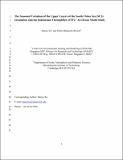| dc.contributor.author | Xu, Danya | |
| dc.contributor.author | Rizzoli, Paola M | |
| dc.date.accessioned | 2017-04-12T20:48:12Z | |
| dc.date.available | 2017-04-12T20:48:12Z | |
| dc.date.issued | 2013-04 | |
| dc.date.submitted | 2013-06 | |
| dc.identifier.issn | 0377-0265 | |
| dc.identifier.uri | http://hdl.handle.net/1721.1/108088 | |
| dc.description.abstract | The upper layer, wind-driven circulation of the South China Sea (SCS), its through-flow (SCSTF) and the Indonesian through flow (ITF) are simulated using a high resolution model, FVCOM (finite volume coastal ocean model) in a regional domain comprising the Maritime Continent. The regional model is embedded in the MIT global ocean general circulation model (ogcm) which provides surface forcing and boundary conditions of all the oceanographic variables at the lateral open boundaries in the Pacific and Indian oceans. A five decade long simulation is available from the MITgcm and we choose to investigate and compare the climatologies of two decades, 1960–1969 and 1990–1999.
The seasonal variability of the wind-driven circulation produced by the monsoon system is realistically simulated. In the SCS the dominant driving force is the monsoon wind and the surface circulation reverses accordingly, with a net cyclonic tendency in winter and anticyclonic in summer. The SCS circulation in the 90s is weaker than in the 60s because of the weaker monsoon system in the 90s. In the upper 50 m the interaction between the SCSTF and ITF is very important. The southward ITF can be blocked by the SCSTF at the Makassar Strait during winter. In summer, part of the ITF feeds the SCSTF flowing into the SCS through the Karimata Strait. Differently from the SCS, the ITF is primarily controlled by the sea level difference between the western Pacific and eastern Indian Ocean. The ITF flow, consistently southwestward below the surface layer, is stronger in the 90s.
The volume transports for winter, summer and yearly are estimated from the simulation through all the interocean straits. On the annual average, there is a ∼5.6 Sv of western Pacific water entering the SCS through the Luzon Strait and ∼1.4 Sv exiting through the Karimata Strait into the Java Sea. Also, ∼2 Sv of SCS water enters the Sulu Sea through the Mindoro Strait, while ∼2.9 Sv flow southwards through the Sibutu Strait merging into the ITF. The ITF inflow occurs through the Makassar Strait (up to ∼62%) and the Lifamatola Strait (∼38%). The annual average volume transport of the ITF inflow from the simulation is ∼15 Sv in the 60s and ∼16.6 Sv in the 90s, very close to the long term observations. The ITF outflow through the Lombok, Ombai and Timor straits is ∼16.8 Sv in the 60s and 18.9 Sv in the 90s, with the outflow greater by 1.7 Sv and 2.3 Sv respectively. The transport estimates of the simulation at all the straits are in rather good agreement with the observational estimates.
We analyze the thermal structure of the domain in the 60s and 90s and assess the simulated temperature patterns against the SODA reanalysis product, with special focus on the shallow region of the SCS. The SODA dataset clearly shows that the yearly averaged temperatures of the 90s are overall warmer than those of the 60s in the surface, intermediate and some of the deep layers and the decadal differences (90s − 60s) indicate that the overall warming of the SCS interior is a local effect. In the simulation the warm trend from the 60s to the 90s in well reproduced in the surface layer. In particular, the simulated temperature profiles at two shallow sites at midway in the SCSTF agree rather well with the SODA profiles. However, the warming trend in the intermediate (deep) layers is not reproduced in the simulation. We find that this deficiency is mostly due to a deficiency in the initial temperature fields provide by the MITgcm. | en_US |
| dc.description.sponsorship | Singapore. National Research Foundation (Singapore-MIT Alliance for Research and Technology Center. Center of Environment Sensing and Modeling Program) | en_US |
| dc.language.iso | en_US | |
| dc.publisher | Elsevier | en_US |
| dc.relation.isversionof | http://dx.doi.org/10.1016/j.dynatmoce.2013.05.002 | en_US |
| dc.rights | Creative Commons Attribution-NonCommercial-NoDerivs License | en_US |
| dc.rights.uri | http://creativecommons.org/licenses/by-nc-nd/4.0/ | en_US |
| dc.source | Prof. Rizzoli via Chris Sherratt | en_US |
| dc.title | The seasonal variation of the upper layers of the South China Sea (SCS) circulation and the Indonesian through flow (ITF): An ocean model study | en_US |
| dc.type | Article | en_US |
| dc.identifier.citation | Xu, Danya, and Paola Malanotte-Rizzoli. “The Seasonal Variation of the Upper Layers of the South China Sea (SCS) Circulation and the Indonesian through Flow (ITF): An Ocean Model Study.” Dynamics of Atmospheres and Oceans 63 (2013): 103–130. | en_US |
| dc.contributor.department | Massachusetts Institute of Technology. Department of Earth, Atmospheric, and Planetary Sciences | en_US |
| dc.contributor.approver | Rizzoli, Paola | en_US |
| dc.contributor.mitauthor | Rizzoli, Paola M | |
| dc.relation.journal | Dynamics of Atmospheres and Oceans | en_US |
| dc.eprint.version | Author's final manuscript | en_US |
| dc.type.uri | http://purl.org/eprint/type/JournalArticle | en_US |
| eprint.status | http://purl.org/eprint/status/PeerReviewed | en_US |
| dspace.orderedauthors | Xu, Danya; Malanotte-Rizzoli, Paola | en_US |
| dspace.embargo.terms | N | en_US |
| dc.identifier.orcid | https://orcid.org/0000-0003-2431-6838 | |
| mit.license | PUBLISHER_CC | en_US |
| mit.metadata.status | Complete | |
